Research on Energy Saving of PHEV Air Conditioning System Based on Reducing Air Backflow in Underhood
Abstract
:1. Introduction
- A heat flux marking method is proposed to characterize the mechanism of air backflow and its distribution in the condenser, thereby quantifying the air backflow phenomenon in the underhood of PHEV.
- The performances of the air conditioning system, including the evaporator outlet temperature, cooling capacity, exhaust pressure of the compressor, and COP, are investigated under different ambient temperatures, air backflow ratios, and air backflow distribution.
- An optimization model of the underhood is proposed to eliminate the impact of air backflow on the air conditioning system of PHEV.
2. Research Method
2.1. Research Framework of the Air Backflow Effect in the Underhood
2.2. 1D Model
2.2.1. Compressor
2.2.2. Condenser and Evaporator Model
2.2.3. Expansion Valve
2.2.4. Fan and Radiator Model
2.3. 3D Models
2.3.1. Heat Exchanger
2.3.2. Meshing of the PHEV Underhood
2.3.3. Boundary Condition
- (1)
- RANS steady-state model is used for steady flow in this model;
- (2)
- Pressure outlet and velocity inlet are selected for outlet and inlet boundary conditions, respectively;
- (3)
- The condenser, intercooler, radiator, and electrical radiator are calculated based on the porous media model;
- (4)
- The cooling fan is simulated based on the multiple reference frame (MRF) method.
2.4. Experimental Test System
2.5. Heat Flux Marking Method
3. Results and Discussion
3.1. Effect of Backflow Rate under Different Ambient Temperatures
3.2. Effect of Air Backflow Rate under the Different Air Backflow Distribution
3.3. Mechanism Analysis of Backflow Phenomenon
3.4. Mechanism Analysis of Air Backflow Phenomenon
4. Conclusions
- (1)
- The heat flux marking method proposed in this paper can accurately quantify the backflow phenomenon in the underhood of PHEV based on the momentum transport equation.
- (2)
- The decrease in the air backflow rate of the underhood helps to improve the refrigeration capacity of the air conditioning system, thereby increasing the COP of the system
- (3)
- When the air backflow ratio cannot be reduced below 10%, the air backflow should be distributed as evenly as possible at the front end of the condenser.
- (4)
- In order to eliminate the impact of air backflow on the PHEV underhood, the gap between the radiator and the bracket is sealed and the gap around the air guide is reduced. Compared with the original structure, the air backflow rate of the optimized structure is reduced from 32.7% to 9.3% and the cabin temperature can be reduced by 3–5 °C.
Author Contributions
Funding
Institutional Review Board Statement
Informed Consent Statement
Data Availability Statement
Conflicts of Interest
Nomenclature
| PHEV | plug-in hybrid electric vehicles |
| ACS | air conditioning system |
| ICE | internal combustion engine |
| UDDS | urban dynamometer driving schedule |
| CFD | computational fluid dynamics |
| EMS | energy management strategy |
| COP | coefficient of performance |
| BTMS | battery thermal management system |
| MTMS | motor thermal management system |
| Acronyms | |
| displacement of the compressor | |
| mass flow of the compressor | |
| energy consumption of the compressor | |
| suction enthalpy of the compressor | |
| exhaust enthalpy under the condition of isentropic compression | |
| density | |
| inertial resistance coefficient | |
| γ | volume proportion of the hot air |
| volumetric flow coefficient | |
| Nusselt number | |
| Prandtl number | |
| linear velocity of the fan blade tip | |
| rotary speed of the compressor | |
| volumetric efficiency of the compressor | |
| exhaust enthalpy of the compressor | |
| isentropic efficiency | |
| heat loss of compressor | |
| velocity vector | |
| viscous resistance coefficient | |
| heat capacity ratio | |
| Reynold number | |
| volume flow of air | |
| Fan Area | |
References
- Solmaz, H.; Ardebili, S.; Calam, A.; Yılmaz, E.; İpci, D. Prediction of Performance and Exhaust Emissions of a CI Engine Fueled with Multi-Wall Carbon Nanotube Doped Biodiesel-Diesel Blends Using Response Surface Method. Energy 2021, 227, 120518. [Google Scholar] [CrossRef]
- Geng, L.; Xiao, Y.; Li, S.; Chen, H.; Chen, X. Effects of injection timing and rail pressure on particulate size-number distribution of a common rail DI engine fueled with fischer-tropsch diesel synthesized from coal. J. Energy Inst. 2021, 95, 219–230. [Google Scholar] [CrossRef]
- Liu, J.; Wu, P.; Sun, P.; Ji, Q.; Zhang, Q.; Wang, P. Effects of iron-based fuel borne catalyst addition on combustion, in-cylinder soot distribution and exhaust emission characteristics in a common-rail diesel engine. Fuel 2021, 290, 120096. [Google Scholar] [CrossRef]
- Zhang, Y.; Yuan, X.; Duan, L.; Xu, Y.; Lan, F. Environmental temperature effects on the energy flow of plug-in hybrid electric vehicles. J. Power Sources 2021, 506, 230231. [Google Scholar] [CrossRef]
- Mahmoodi-k, M.; Montazeri, M.; Madanipour, V. Simultaneous multi-objective optimization of a PHEV power management system and component sizing in real world traffic condition. Energy 2021, 233, 121111. [Google Scholar] [CrossRef]
- Aljehane, N.; Mansour, R. Optimal allocation of renewable energy source and charging station for PHEVs. Sustain. Energy Technol. Assess. 2021, 49, 101669. [Google Scholar] [CrossRef]
- Böhme, T.; Frank, B. Hybrid Systems, Optimal Control and Hybrid Vehicles; Springer: Berlin/Heidelberg, Germany, 2017. [Google Scholar]
- Hemmati, S.; Doshi, N.; Hanover, D.; Morgan, C.; Shahbakhti, M. Integrated cabin heating and powertrain thermal energy management for a connected hybrid electric vehicle. Appl. Energy 2021, 283, 116353. [Google Scholar] [CrossRef]
- Liu, J.; Chen, Y.; Li, W.; Shang, F.; Zhan, J. Hybrid-Trip-Model-Based Energy Management of a PHEV with Computation-Optimized Dynamic Programming. IEEE Trans. Veh. Technol. 2018, 67, 338–353. [Google Scholar] [CrossRef]
- Fan Li Zhang, Y.; Dou, H.; Zou, R. Design of an integrated energy management strategy for a plug-in hybrid electric bus. J. Power Sources 2019, 448, 227391. [Google Scholar] [CrossRef]
- Chen, Z.; Xiong, R.; Cao, J. Particle swarm optimization-based optimal power management of plug-in hybrid electric vehicles considering uncertain driving conditions. Energy 2016, 96, 197–208. [Google Scholar] [CrossRef]
- Liu, T.; Hu, X.; Li, S.; Cao, D. Reinforcement Learning Optimized Look-Ahead Energy Management of a Parallel Hybrid Electric Vehicle. IEEE Trans. Mechatron. 2017, 22, 1497–1507. [Google Scholar] [CrossRef]
- Peng, J.; He, H.; Xiong, R. Rule based energy management strategy for a series-parallel plug-in hybrid electric bus optimized by dynamic programming. Appl. Energy 2017, 185, 1633–1643. [Google Scholar] [CrossRef]
- Song, P.; Lei, Y.; Fu, Y. Multi-objective optimization and matching of power source for PHEV based on genetic algorithm. Energies 2020, 13, 1127. [Google Scholar] [CrossRef] [Green Version]
- Ribau, J.; Sousa, J.; Silva, C. Multi-Objective Optimization of Fuel Cell Hybrid Vehicle Powertrain Design—Cost and Energy; SAE Technical Paper; SAE: Detroit, MI, USA, 2013. [Google Scholar] [CrossRef]
- Qi, X.; Wu, G.; Boriboonsomsin, K.; Barth, M.J. Development and evaluation of an evolutionary algorithm-based online energy management system for plug-in hybrid electric vehicles. IEEE Trans. Intell. Transp. Syst. 2017, 18, 2181–2191. [Google Scholar] [CrossRef]
- Silva, S.; Eckert, J.; Silva, F.; Silva, L.; Dedini, F. Multi-objective optimization design and control of plug-in hybrid electric vehicle powertrain for minimization of energy consumption, exhaust emissions and battery degradation. Energy Convers. Manag. 2021, 234, 113909. [Google Scholar] [CrossRef]
- Pan, L.; Liu, C.; Zhang, Z.; Wang, T.; Shi, J.; Chen, J. Energy-saving effect of utilizing recirculated air in electric vehicle air conditioning system. Int. J. Refrig. 2019, 12, 122–129. [Google Scholar] [CrossRef]
- Zhang, Z.; Liu, C.; Chen, X.; Zhang, C.; Chen, J. Annual energy consumption of electric vehicle air conditioning in China. Appl. Therm. Eng. 2017, 125, 567–574. [Google Scholar] [CrossRef]
- Oh, M.; Ahn, J.; Kim, D.; Jang, D.; Kim, Y. Thermal comfort and energy saving in a vehicle compartment using a localized air-conditioning system. Appl. Energy 2014, 133, 14–21. [Google Scholar] [CrossRef]
- Jeffers, M.; Chaney, L.; Rugh, J. Climate Control Load Reduction Strategies for Electric Drive Vehicles in Warm Weather; SAE Technical Paper; SAE: Detroit, MI, USA, 2015. [Google Scholar] [CrossRef] [Green Version]
- Liu, Y.; Gao, Q.; Zhang, T.; Cui, C.; Jin, S. Exploration of interactive thermal influence characteristics of power and air conditioning system based on 1D/3D coupling calculation in electric vehicle underhood. Appl. Therm. Eng. 2020, 167, 114717. [Google Scholar] [CrossRef]
- Hofstadtera, R.; Jorge, A.; Kozek, M. Energy optimal control of thermal comfort in trams. Appl. Therm. Eng. 2018, 143, 812–821. [Google Scholar] [CrossRef]
- Collier, J.; Thome, J. Convective Boiling and Condensation, 3rd ed.; Oxford University Press: Oxford, UK.
- Shen, M.; Gao, Q. System simulation on refrigerant-based battery thermal management technology for electric vehicles. Energy Convers. Manag. 2020, 203, 112176. [Google Scholar] [CrossRef]
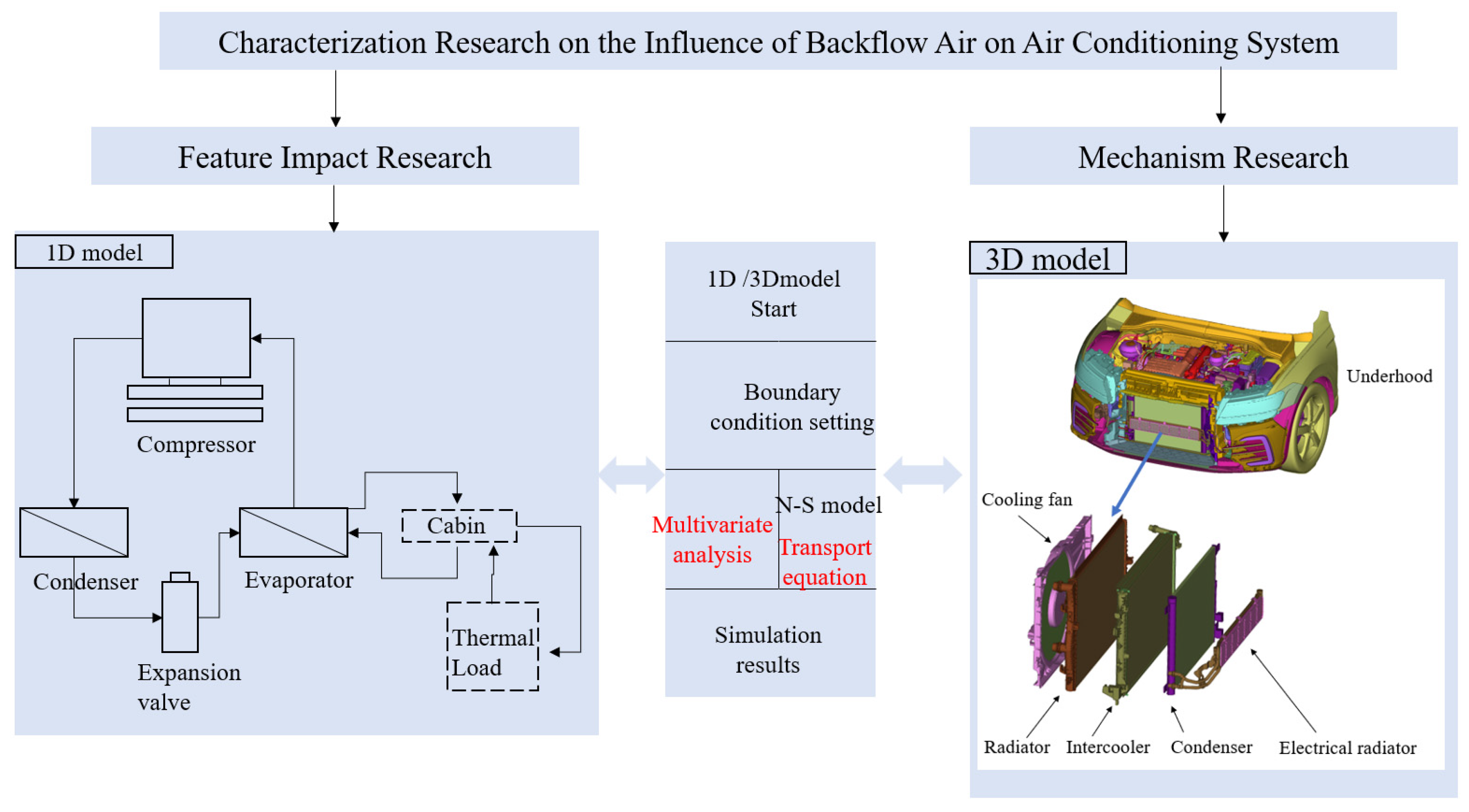

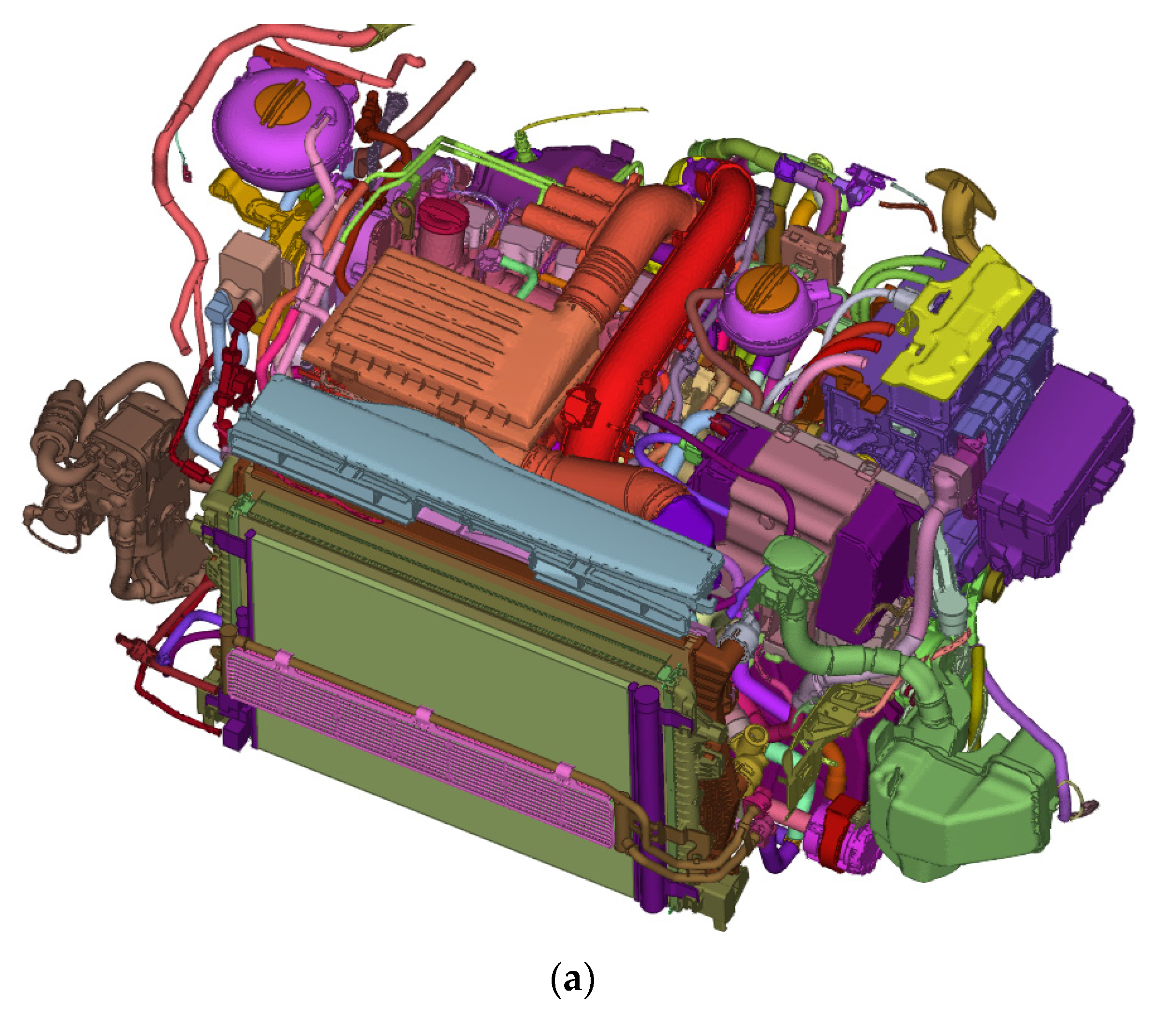


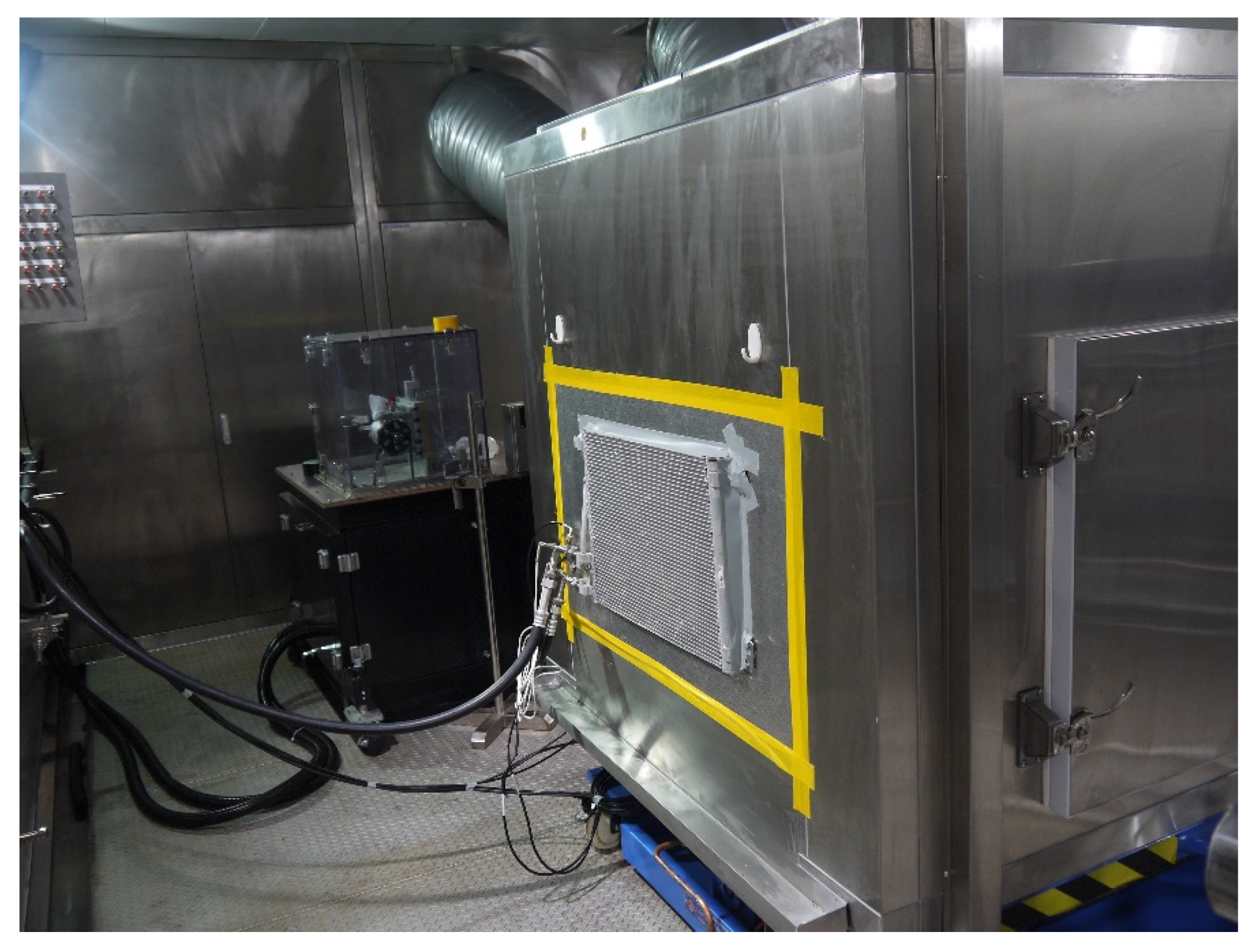
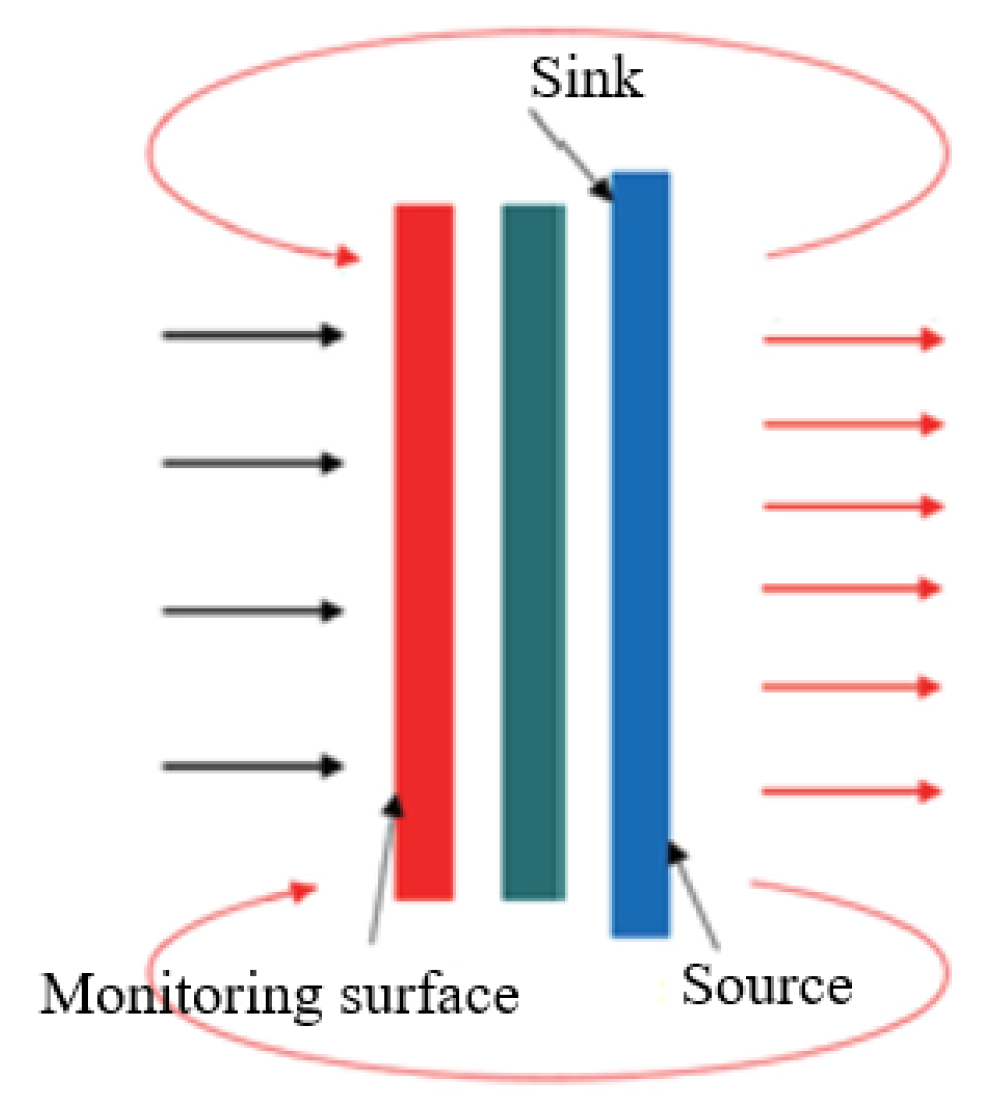
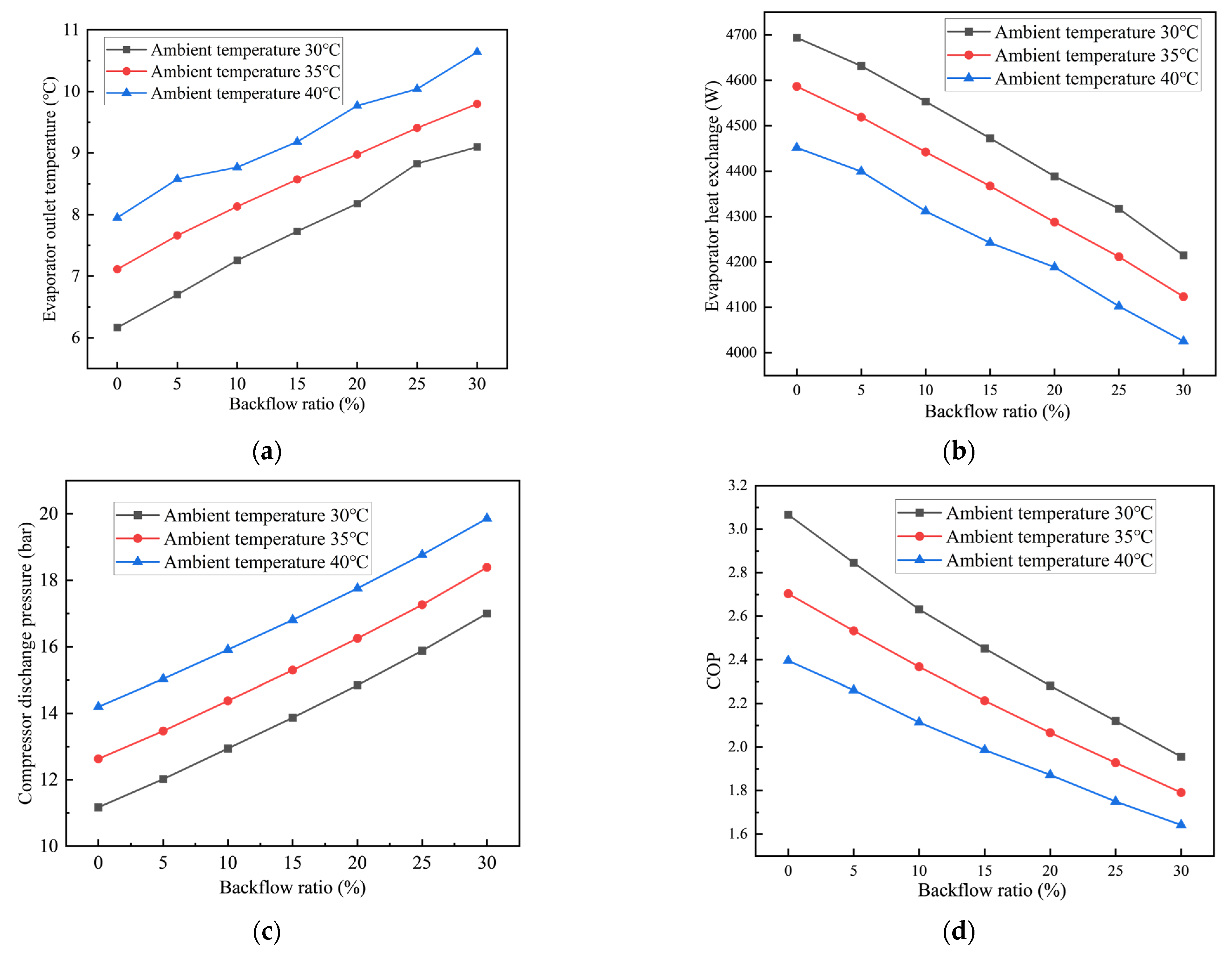
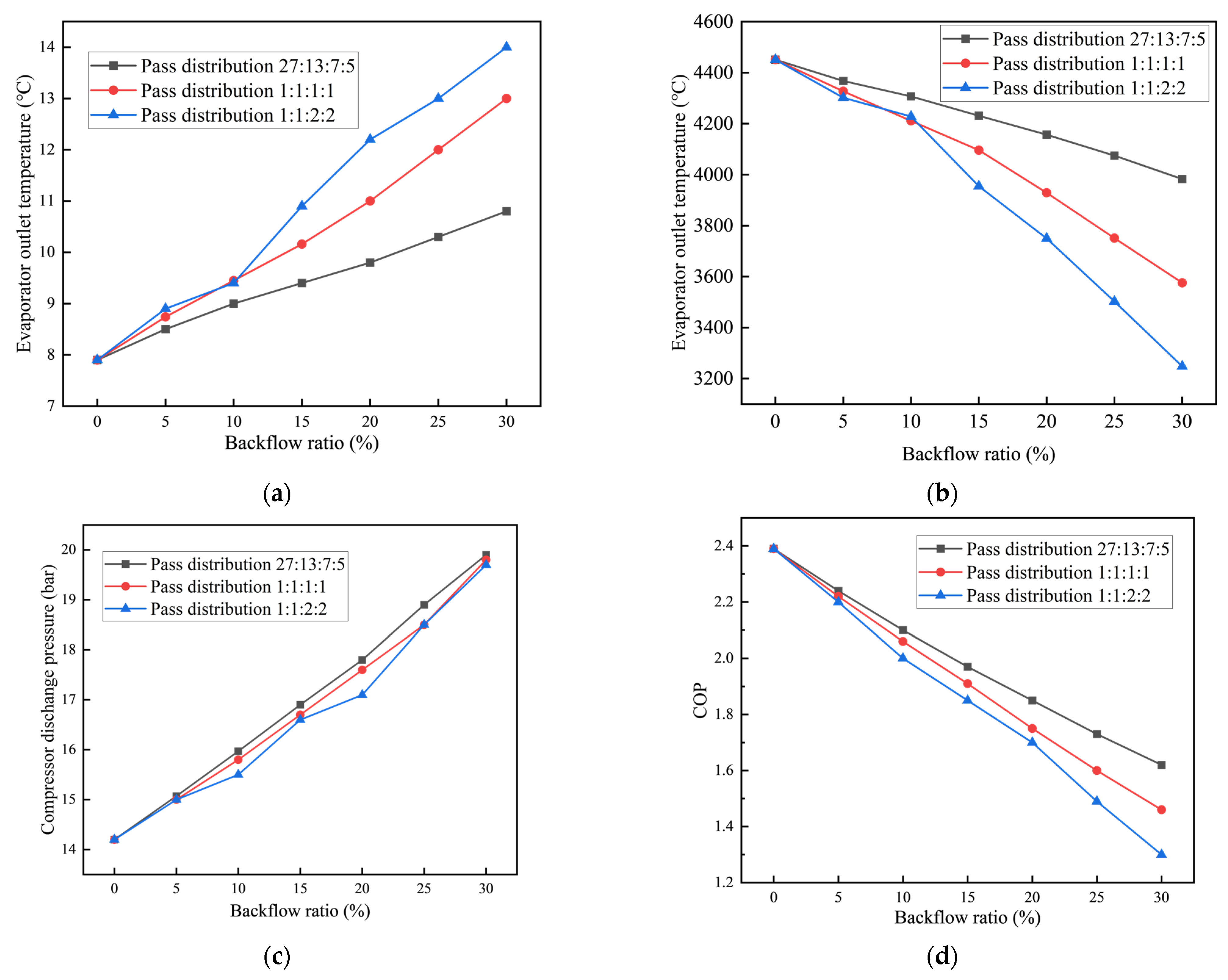

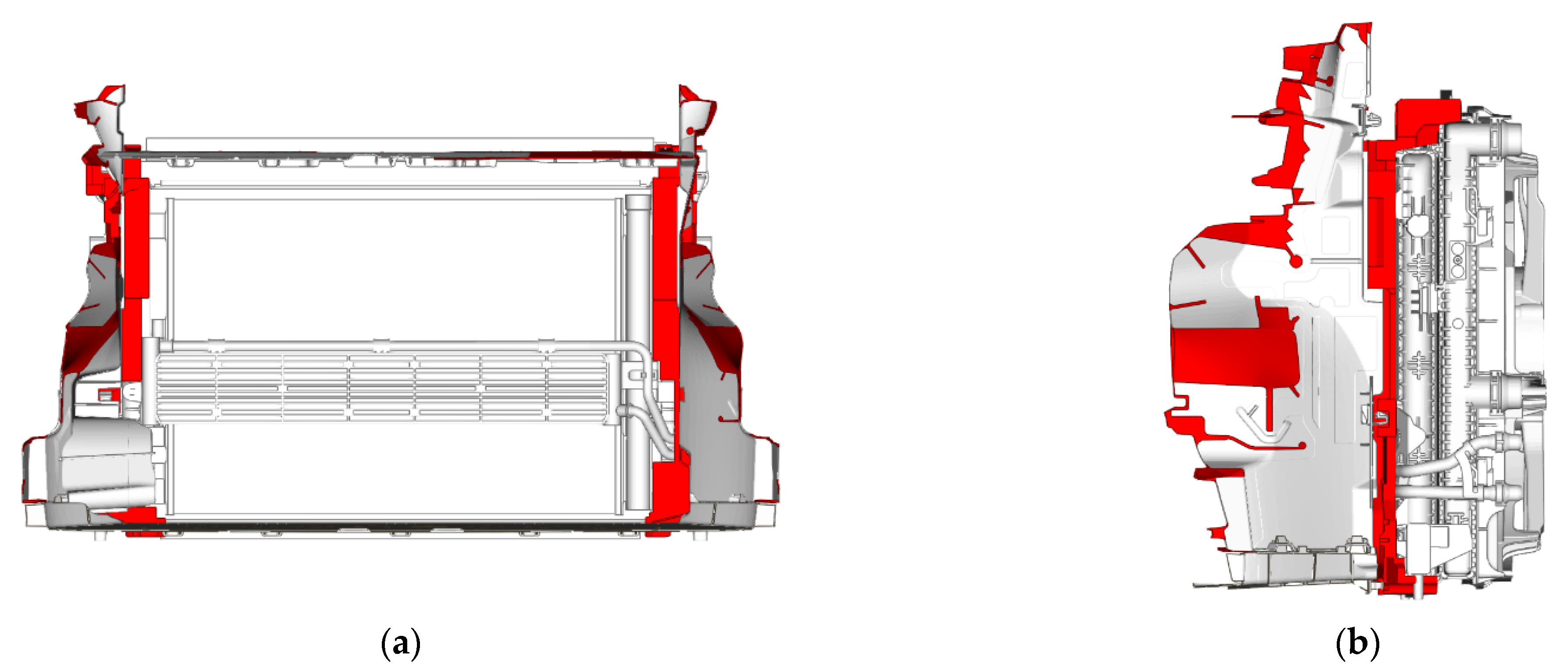


| Heat Exchanger | Viscous Resistance Coefficient (m−2) | Inertial Resistance Coefficient (m−1) |
|---|---|---|
| Radiator | 1192.5 | 160.1 |
| Intercooler | 813.6 | 74.5 |
| Condenser | 851.8 | 126.9 |
| Electrical radiator | 808.2 | 114.3 |
| Air Mass Flow (kg/s) | Backflow Ratio (%) | Backflow Air Mass Flow (kg/s) | |
|---|---|---|---|
| Original Structure | 0.518 | 32.7 | 0.169 |
| Optimized structure | 0.518 | 9.3 | 0.048 |
Publisher’s Note: MDPI stays neutral with regard to jurisdictional claims in published maps and institutional affiliations. |
© 2022 by the authors. Licensee MDPI, Basel, Switzerland. This article is an open access article distributed under the terms and conditions of the Creative Commons Attribution (CC BY) license (https://creativecommons.org/licenses/by/4.0/).
Share and Cite
Wu, H.; Tang, X.; Xu, S.; Zhou, J. Research on Energy Saving of PHEV Air Conditioning System Based on Reducing Air Backflow in Underhood. Energies 2022, 15, 3183. https://doi.org/10.3390/en15093183
Wu H, Tang X, Xu S, Zhou J. Research on Energy Saving of PHEV Air Conditioning System Based on Reducing Air Backflow in Underhood. Energies. 2022; 15(9):3183. https://doi.org/10.3390/en15093183
Chicago/Turabian StyleWu, Haibo, Xingwang Tang, Sichuan Xu, and Jiangbin Zhou. 2022. "Research on Energy Saving of PHEV Air Conditioning System Based on Reducing Air Backflow in Underhood" Energies 15, no. 9: 3183. https://doi.org/10.3390/en15093183
APA StyleWu, H., Tang, X., Xu, S., & Zhou, J. (2022). Research on Energy Saving of PHEV Air Conditioning System Based on Reducing Air Backflow in Underhood. Energies, 15(9), 3183. https://doi.org/10.3390/en15093183






